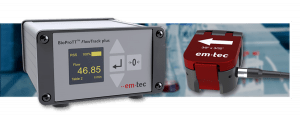 The BioProTTTM FlowMeasurement System for the non-invasive measurement of volumetric flows within flexible tubing systems is suitable for both industrial and laboratory applications. It always consists of an evaluation device and a sensor.
The BioProTTTM FlowMeasurement System for the non-invasive measurement of volumetric flows within flexible tubing systems is suitable for both industrial and laboratory applications. It always consists of an evaluation device and a sensor.
To ensure the highest possible accuracy, each sensor is adjusted and calibrated according to certain parameters based on the customer’s application. In addition, there are also external factors that impact the accuracy. This document will highlight and explain these factors so that system integrators and operators are able to maintain and optimize the accuracy on-site.
Main influences on the accuracy include the following aspects:
Sensor Positioning:
For best results, the sensor should be clamped onto a straight section of the tube. Ideally, the straight section should have a length of 15 times the inner diameter (ID) of the tube on either side of the sensor.
Most setups within the bioprocessing field include pumps and valves, both of which influence the flow. While it is possible to position the sensor on either side of the pump, the distance between the sensor and the pump should always be large enough for the flow to stabilize.
Additionally, the flow path should be aligned to ensure that there is no air in the tube and that the fluid can be completely still once the pump was turned off.
Moreover, the arrow on the sensor lid should point into the flow direction.
Application Parameters:
When setting up the system, users must ensure that the sensor and tube are compatible. Every sensor is pre-adjusted and calibrated according to customer specifications regarding the relevant parameters such as medium type and temperature; tube size and material; and the flow range, since they all influence the ultrasonic signals.
Measurement:
When the BioProTT™ FlowMeasurement System is set up and the sensor is clamped onto the tube, it is recommended to wait for five to ten minutes before starting the measurement so that the tube and the BioProTT™ FlowMeasurement System can equilibrate and adapt to the ambient conditions.
For ultrasonic measurement systems, the acoustic coupling rate or RSS (Received Signal Strength) value describes the signal strength and thus the quality of the ultrasonic signal. The RSS value is displayed as a percentage and should always exceed 50%. One of the key aspects for optimizing and maintaining the measurement accuracy is the zero flow adjustment. It levels any existing offsets, and therefore has a large impact on the accuracy. As a result, a zero flow adjustment (also referred to as “zeroing”) must be carried out before each new measurement and, ideally, whenever possible without disturbing the running process.
Maintenance:
The BioProTT™ FlowMeasurement System needs comparatively little maintenance or care. The sensors in particular are designed for long-term use and made to last. Nevertheless, in order to maintain and optimize the system’s accuracy, regular re-calibrations (i.e. every 24 months) are recommended.
Of course, the devices should also be cleaned and checked for damages regularly.
